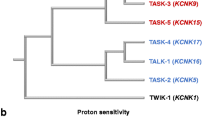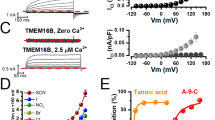Abstract
Single ATP-sensitive potassium channels (K ATP channels) were studied in inside-out membrane patches excised from mouse skeletal muscle. Channel blockage by the non-hydrolysable ATP analogue AMP-PNP was investigated in the absence or presence of 1 mM MgCl2 with K+-rich solutions bathing the internal membrane surface. Currents through single. K ATP channels were recorded at −40 and +40 mV AMP-PNP (5 to 500 μM; Li salt) reduced the open-probability po of K ATP channels and decreased the single-channel currents at high nucleotide concentrations by approximately 10%. Half maximal reduction of po at −40 mV was observed at nucleotide concentrations of 29 μM in the absence and of 39 μM in the presence of Mg2+. The steepness of the AMP-PNP concentration-response curves was strongly affected by Mg2+, the Hill coefficients of the curves were 0.6 in the absence and 1.6 in the presence of 1 mM MgCl2. The efficacies of channel blockage by AMP-PNP at −40 and +40 mV were not significantly different. The results indicate that a K ATP channel can bind more divalent Mg2+-complexes of AMP-PNP than trivalent protonated forms of the nucleotide and that channel blockage is hardly affected by the membrane electric field. To estimate the contribution of lithium ions to the observed results, we studied the effects of LiCl (0.8 to 10 mM) in the Mg2+-free solution on the single channel current i. At a Li+ concentration of 10 mM, i was hardly affected at −40 mV but reduced by a factor of 0.75 at +40 mV. The results are interpreted by a fast, voltage-dependent blockage of K ATP channels by internal Li+ ions.
Similar content being viewed by others
References
Allard B, Lazdunski M (1992) Nucleotide diphosphates activate the ATP-sensitive potassium channel in mouse skeletal muscle. Pflügers Arch 422:185–192
Ashcroft FM, Kakei M (1989) ATP-sensitive K+ channels in rat pancreatic β-cells: modulation by ATP and Mg2+ ions. J Physiol (London) 416:349–367
Ashcroft SJH, Ashcroft FM (1990) Properties and functions of ATP-sensitive K-channels. Cell Signal 2:197–214
Ashford MLJ, Sturgess NC, Trout NJ, Gardner NJ, Hales CN (1988) Adenosine-5′-triphosphate-sensitive ion channels in neonatal rat cultured central neurones. Pflügers Arch 412:297–304
Benz I, Kohlhardt M (1992) Differential sensitivity of cardiac K + (ATP) channels to guanine nucleotides — evidence for a heterogeneous channel population. Eur Biophys J 21:299–302
Bodewei R, Hehl S, Neumcke B (1992) The cardiotonic bipyridine AWD 122–60 inhibits adenosine triphosphate-sensitive potassium channels of mouse skeletal muscle. Naunyn-Schmiedeberg's Arch Pharmacol 345:570–577
Botts J, Chashin A, Young HL (1965) Alkali metal binding by ethylenediaminetetraacetate, adenosine 5′-triphosphate, and pyrophosphate. Biochemistry 4:1788–1796
Colquhoun D, Hawkes AG (1983) The principles of the stochastic interpretation of ion-channel mechanisms. In: Sakmann B, Neher E (eds) Single-Channel Recording. Plenum Press, New York, pp 135–175
Davies NW, Spruce AE, Standen NB, Stanfield PR (1989) Multiple blocking mechanisms of ATP-sensitive potassium channels of frog skeletal muscle by tetraethylammonium ions. J Physiol (London) 413:31–48
Davies NW, Pettit AI, Agarwal R, Standen NB (1991) The flickery block of ATP-dependent potassium channels of skeletal muscle by internal 4-aminopyridine. Pflugers Arch 419:25–31
Findlay I (1988a) Effects of ADP upon the ATP-sensitive K+ channel in rat ventricular myocytes. J Membr Biol 101:83–92
Findlay I (1988b) ATP4− and ATP · Mg inhibit the ATP-sensitive K+ channel of rat ventricular myocytes. Pflügers Arch 412:37–41
Forestier C, Vivaudou M (1993) Modulation by Mg2+ and ADP of ATP-sensitive potassium channels in frog skeletal muscle. J Membr Biol 132:87–94
Hamill OP, Marty A, Neher E, Sakmann B, Sigworth FJ (1981) Improved patch-clamp techniques for high-resolution current recording from cells and cell-free membrane patches. Pflügers Arch 391:85–100
Hehl S, Neumcke B (1993a) Effects of AMP-PNP on K ATP channels in mouse skeletal muscle. Pflugers Arch 422 (Suppl. 1):R75 (Abstract)
Hehl S, Neumcke B (1993b) Negative cooperativity may explain flat concentration-response curves of ATP-sensitive potassium channels. Eur Biophys J 22:1–4
Hehl S, Moser Ch, Weik R, Neumcke B (1994) Internal Ca2+ ions inactivate and modify ATP-sensitive potassium channels in adult mouse skeletal muscle. Biochim Biophys Acta 1190:257–263
Hille B (1992) Ionic channels of excitable membranes, 2nd edn. Massachusetts: Sinauer Associates, Sunderland
Horn R (1991) Estimating the number of channels in patch recordings. Biophys J 60:433–439
Neumcke B, Weik R (1991) Vanadate as an activator of ATP-sensitive potassium channels in mouse skeletal muscle. Eur Biophys J 19:119–123
Nichols CG, Lederer WJ, Cannell MB (1991) ATP dependence of K ATP channel kinetics in isolated membrane patches from rat ventricle. Biophys J 60:1164–1177
Pettit LD, Siddiqui KF (1976) The proton and metal complexes of adenyl-5′-yl imidodiphosphate. Biochem J 159:169–171
Schwanstecher C, Dickel C, Panten U (1992) Cytosolic nucleotides enhance the tolbutamide sensitivity of the ATP-dependent K+ channel in mouse pancreatic B cells by their combined actions at inhibitory and stimulatory receptors. Mol Pharmacol 41:480–486
Spruce AE, Standen NB, Stanfield PR (1985) Voltage-dependent ATP-sensitive potassium channels of skeletal muscle membrane. Nature 316:736–739
Tung RT, Kurachi Y (1991) On the mechanism of nucleotide diphosphate activation of the ATP-sensitive K+ channel in ventricular cell of guinea-pig. J Physiol (London) 437:239–256
Woll KH, Lönnendonker U, Neumcke B (1989) ATP-sensitive potassium channels in adult mouse skeletal muscle: different modes of blockage by internal cations, ATP and tolbutamide. Pflugers Arch 414:622–628
Yount RG, Babcock W, Ballantyne W, Ojala D (1971) Adenylyl imidodiphosphate, an adenosine triphosphate analog containing a P-N-P linkage. Biochemistry 10:2484–2489
Author information
Authors and Affiliations
Additional information
Correspondence to: B. Neumcke
Rights and permissions
About this article
Cite this article
Hehl, S., Neumcke, B. KATP channels of mouse skeletal muscle: mechanism of channel blockage by AMP-PNP. Eur Biophys J 23, 231–237 (1994). https://doi.org/10.1007/BF00213573
Received:
Accepted:
Issue Date:
DOI: https://doi.org/10.1007/BF00213573




